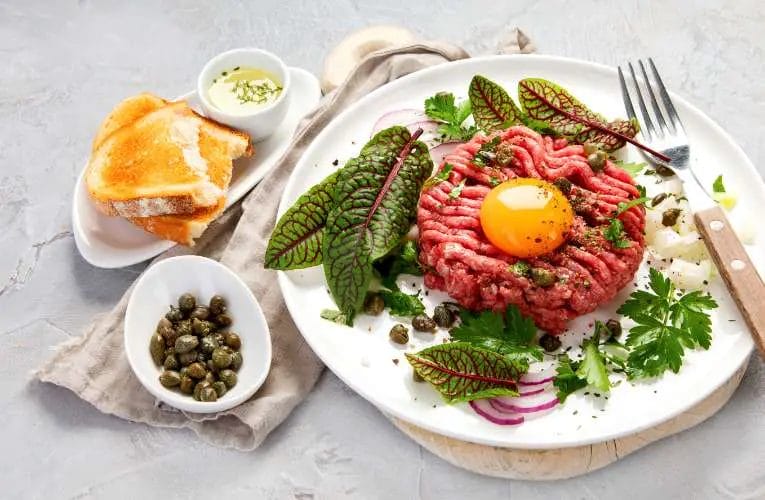Are you wondering if steak tartare is a healthy choice?
Steak tartare is a traditional French dish made from raw minced beef, often seasoned with spices and served with accompaniments. While it can be a delicious and indulgent treat, it’s important to consider the health implications.
Raw meat poses a risk of bacterial contamination, and consuming undercooked beef can increase the risk of foodborne illnesses. It’s advisable to exercise caution and ensure the quality and freshness of the ingredients when enjoying this dish.

Tips for Preparing Healthy Steak Tartare
Steak tartare is a classic French dish that consists of finely chopped raw beef, typically seasoned with herbs and spices.
While it may seem intimidating to prepare raw meat, with the right techniques and ingredients, you can create a delicious and healthy steak tartare. Here are some tips to help you prepare a safe and tasty dish:
1. Choose High-Quality Beef
One of the most important aspects of preparing steak tartare is choosing high-quality beef. Opt for lean cuts of beef, such as filet mignon or sirloin, that are fresh and preferably organic. It’s crucial to select beef that comes from a reputable source to minimize the risk of foodborne illnesses.
2. Practice Proper Meat Handling
When handling raw meat, it’s essential to follow proper food safety practices. Use separate cutting boards, utensils, and plates for raw meat to avoid cross-contamination. Make sure to wash your hands thoroughly after handling raw beef and clean all surfaces that come into contact with the meat.
3. Freeze the Beef
To further reduce the risk of any harmful bacteria, consider freezing the beef before preparing the tartare. Freezing the meat at a temperature below -4°F (-20°C) for at least 48 hours can help kill potential parasites and pathogens. Thaw the meat in the refrigerator before using it for the tartare.
4. Use Fresh Ingredients
Aside from the beef, use fresh and high-quality ingredients to enhance the flavors of your steak tartare. This includes finely chopped shallots, capers, parsley, Dijon mustard, and Worcestershire sauce. Opt for organic and locally sourced ingredients whenever possible.
5. Balance the Flavors
When seasoning the tartare, it’s crucial to balance the flavors. Start with a small amount of each ingredient and adjust accordingly based on your taste preferences.
Remember to go easy on the salt, as the beef already has a natural flavor. A dash of freshly ground black pepper can add a nice touch of spice.
6. Consider Adding Healthy Fats
While traditional steak tartare is made with lean beef, you can also incorporate healthy fats into the dish. Consider adding a small amount of extra virgin olive oil or avocado oil to give the tartare a creamier texture and boost its nutritional value.
7. Serve with Fresh Accompaniments
Steak tartare is often served with accompaniments like fresh lettuce leaves, cornichons, and toasted bread or crackers.
These additions not only add crunch and freshness to the dish but also provide additional nutrients. Opt for whole-grain bread or gluten-free crackers for a healthier twist.
8. Enjoy Immediately
Steak tartare is best enjoyed immediately after preparation. Avoid letting the dish sit for too long, as the flavors may change, and the texture may become less desirable. Serve it right away to savor the freshness of the ingredients and the tenderness of the beef.
Preparing healthy steak tartare requires attention to detail and adherence to food safety guidelines. By following these tips, you can create a delicious and safely prepared dish to enjoy as a gourmet treat or special occasion meal.

Variations of Healthy Steak Tartare Recipes
Steak Tartare is a classic dish that has been enjoyed for centuries. Traditionally made with raw, minced beef, this delicacy is known for its rich flavors and unique texture.
However, many people are looking for healthier alternatives to enjoy this beloved dish. In this section, we will explore some variations of healthy Steak Tartare recipes that you can try at home.
1. Salmon Tartare
If you’re looking to switch things up, why not try a seafood twist on the classic Steak Tartare? Salmon Tartare is a popular alternative that offers a lighter and fresher taste.
Simply replace the beef with fresh, high-quality salmon. Chop the salmon into small, bite-sized pieces and season it with ingredients like lemon juice, olive oil, capers, and dill. Serve it alongside some toasted bread or crackers for a delicious and healthy appetizer.
2. Tuna Tartare
Another great seafood option for a healthy Steak Tartare variation is Tuna Tartare. Tuna is packed with omega-3 fatty acids and is a great source of lean protein.
To make Tuna Tartare, finely chop fresh tuna and mix it with ingredients like soy sauce, sesame oil, ginger, and scallions. You can add some avocado or mango for a touch of sweetness. Serve it with crispy wonton chips or lettuce cups for a refreshing and nutritious meal.
3. Mushroom Tartare
If you’re a vegetarian or simply want to try a plant-based alternative, Mushroom Tartare is a fantastic choice. Mushrooms have a meaty texture and offer a rich umami flavor that can mimic the taste of beef.
Finely chop a combination of mushrooms like portobello, shiitake, and oyster mushrooms. Mix them with ingredients like balsamic vinegar, garlic, herbs, and spices.
You can serve the Mushroom Tartare on a bed of arugula or with some crusty bread for a satisfying and healthy dish.
4. Beetroot Tartare
For a vibrant and colorful twist on Steak Tartare, try Beetroot Tartare. This vegetarian option is not only visually appealing but also packed with nutrients. Grate or finely dice some roasted beetroots and mix them with ingredients like lemon juice, olive oil, red onion, and parsley.
The earthy flavors of the beets combined with the tangy dressing create a delicious and healthy dish. Serve it with some toasted nuts or seeds for added crunch.
5. Quinoa Tartare
If you’re looking for a gluten-free and protein-packed alternative, Quinoa Tartare is a fantastic choice. Cook some quinoa according to the package instructions and let it cool. Add finely chopped vegetables like cucumber, tomato, red bell pepper, and red onion to the quinoa.
For the dressing, mix together lemon juice, olive oil, garlic, and herbs. The combination of quinoa and fresh vegetables creates a light and nutritious dish that is perfect for a healthy lunch or dinner option.

Potential Health Risks and Safety Concerns of Steak Tartare
While steak tartare can be a delicious and indulgent dish for meat lovers, it is important to be aware of the potential health risks and safety concerns associated with consuming raw or undercooked meat.
Here, we will discuss some of the main concerns that should be considered before enjoying this traditional delicacy.
1. Bacterial Contamination
Raw meat, including beef used in steak tartare, may contain harmful bacteria such as Salmonella, Escherichia coli (E. coli), and Campylobacter.
These bacteria can cause foodborne illnesses and lead to symptoms such as abdominal pain, diarrhea, vomiting, and in severe cases, dehydration and kidney failure.
It is important to note that cooking meat to the proper internal temperature can kill these bacteria and significantly reduce the risk of infection. However, steak tartare is typically prepared without cooking the meat, which increases the chances of bacterial contamination.
2. Parasitic Infections
Another significant concern associated with raw or undercooked meat is the risk of parasitic infections. Certain parasites, such as Toxoplasma gondii and Trichinella spiralis, can be present in raw beef and cause serious health issues in humans.
Toxoplasma gondii is particularly dangerous for pregnant women as it can lead to congenital disabilities in the unborn child. Trichinella spiralis, on the other hand, can cause trichinellosis, a parasitic infection that can result in muscle pain, fever, swelling, and in severe cases, even life-threatening complications.
3. Cross-Contamination
Cross-contamination is a major concern when handling raw meat. If proper food safety practices are not followed, the bacteria present in raw beef can spread to other surfaces, utensils, or foods, increasing the risk of foodborne illnesses.
It is crucial to separate raw meat from other ingredients, utensils, and surfaces during preparation. Cutting boards, knives, and other equipment used for raw meat should be thoroughly washed and sanitized to prevent the transfer of harmful bacteria.
4. Allergic Reactions
Some individuals may have allergies or sensitivities to certain proteins found in raw beef. The consumption of steak tartare can potentially trigger allergic reactions, ranging from mild symptoms such as itching and hives to more severe reactions like difficulty breathing or anaphylaxis.
If you have a known allergy or sensitivity to beef or any other meat products, it is important to avoid consuming raw or undercooked meat dishes like steak tartare.
5. High Cholesterol and Fat Content
Steak tartare is traditionally made from high-quality cuts of beef, which tend to have a higher fat content compared to leaner cuts. While some fats are essential for a balanced diet, excessive consumption of saturated fats can contribute to high cholesterol levels and increase the risk of heart disease.
If you are watching your cholesterol intake or have a history of heart conditions, it is advisable to consume steak tartare in moderation or opt for leaner alternatives.

Incorporating Steak Tartare into a Balanced Diet
When it comes to a balanced diet, many people often think of bland, boring meals that lack excitement. However, with the right approach, you can incorporate delicious and adventurous dishes without compromising on nutrition. One such dish is steak tartare, a classic French delicacy.
Steak tartare is a raw meat dish that is typically made with high-quality beef, such as tenderloin or sirloin. It is often seasoned with spices, herbs, onions, capers, and Worcestershire sauce to enhance the flavors.
While the idea of eating raw meat may seem intimidating, when prepared properly, steak tartare can be a safe and healthy addition to your diet. Here are some tips on how to incorporate steak tartare into a balanced diet:
1. Choose high-quality ingredients
When making steak tartare, it is essential to choose fresh, high-quality ingredients. Look for lean cuts of beef that are fresh and preferably grass-fed. Grass-fed beef is not only rich in omega-3 fatty acids but also contains higher levels of vitamins and minerals compared to grain-fed beef.
2. Proper food handling and preparation
Since steak tartare is made with raw meat, it is crucial to practice proper food handling and preparation techniques to minimize the risk of foodborne illnesses.
Make sure to buy the meat from a reliable source and keep it refrigerated until you are ready to prepare the dish. Clean all utensils and surfaces thoroughly before and after handling the raw meat.
3. Balance the nutrients
To make steak tartare a part of a balanced diet, it is important to pair it with other nutrient-rich foods. Serve it with a variety of fresh, colorful vegetables like mixed greens, tomatoes, and onions.
These vegetables provide essential vitamins, minerals, and fiber. You can also include a side of whole grain bread or crackers for added carbohydrates.
4. Portion control
While steak tartare can be delicious, it is important to exercise portion control. Since it is a high-protein dish, it can be quite filling even in small portions.
Consider serving it as an appetizer or a small plate rather than a main course. This will help you maintain a balanced intake of other essential nutrients, such as carbohydrates and fats.
5. Enjoy in moderation
As with any food, moderation is key. While steak tartare can be a tasty addition to your diet, it is best enjoyed in moderation.
It is not recommended to consume raw or undercooked meat frequently, as it may increase the risk of bacterial infections. It is also important to listen to your body and make sure that you do not have any allergies or sensitivities to raw meat.

FAQs
Is steak tartare healthy?
Steak tartare can be a healthy choice if prepared properly. It is a raw minced beef dish that is rich in protein and essential nutrients.
However, it carries a risk of bacterial contamination, so it is important to use high-quality, fresh ingredients and handle them with care to minimize the risk of foodborne illnesses.
Conclusion
In conclusion, while steak tartare is a delicious and popular dish, its health benefits should be considered. While it is a good source of protein, iron, and other essential nutrients, the risk of consuming raw meat cannot be ignored.
It is crucial to ensure that the beef used in steak tartare is of high quality and properly handled to minimize the risk of foodborne illnesses. Additionally, individuals with certain medical conditions or compromised immune systems should exercise caution when consuming raw or undercooked meat.
Ultimately, moderation and balance are key when enjoying steak tartare or any other raw meat dish.

